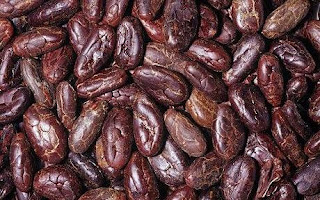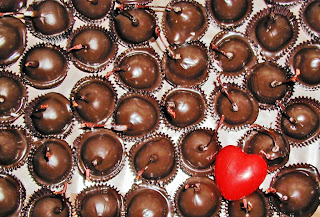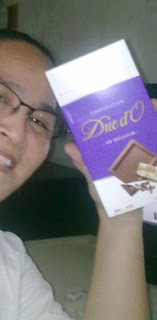Genus and Species: Theobroma cacao Also Known As: Chocolate, cacao Parts Used:Seed (often called bean) |
Here is a picture of the Cacao Fruit where the seeds used to make chocolate and cocoa are found. YUM!!
puno ng kakaw
A few years ago a burst of publicity surrounded a report suggesting that eating chocolate causes the release of brain chemicals responsible for the feeling of being in love. Though this research is yet to be confirmed, your favorite vice may just be what the doctor ordered! Cocoa and its derivative chocolate, may aid digestion, boost blood flow to the heart, and help anyone with chest congestion breathe easier. Read on!!
THE NOT SO SWEET HISTORY OF CHOCOLATE
Chocolate was once a rare and exotic luxury reserved only for the wealthy and priviledged.
When Columbus landed in the New World, the native people were already cultivating the cacao tree for its precious fruit, the cacao bean, from which chocolate was ultimately extracted. It was Columbus himself who introduced the cacao bean to Europe, presenting a handful of dried beans to a rather indignant Spanish court, disdainful of the humble-appearing beans.
When the Spanish Conquistador Hernando Cortez and his soldiers marched into the Aztec capital of Tenochtitlan (Mexico City) he found the emporer Montezuma and his nobles drinking a brown, bitter tasting drink from golden goblets in a sacred daily ritual. They called this drink Xocolatl. They believed that the drink endowed them with supernatural powers and bestowed health, strength, longevity, and sexual vigor. It was considered a gift from the Gods (In fact, 100 cacao beans could buy a healthy human slave).
tsokolate sa box
Once the Spanish nobility put aside their disdain for the beans and tasted the chocolate drink they became passionate devotees (1660's). For European tastes, however, the drink was too bitter, so they sweetened it with sugar and milk and sometimes added spices like nutmeg.
In 1828 the cocoa press was invented making the process of grinding cacao beans easier. Before, chocolate was gritty and grainy, similar to coffee without the grounds removed. But now, the quality of chocolate liquor was improved.
choco-liquor drink
A Swiss inventor Daniel Peter experimented with the addition of milk to so that the liquor could be molded and allowed to harden and eaten in solid form. It was extremely successful!!!!
KISS THESE RUMORS GOODBYE!!
Chocolate does not cause:
Acne, Tooth decay, Heart disease, Kidney stones, Headaches, Infant colic, High cholesterol, and Obesity. Also very few incidents of chocolate allergy are reported. Often, chocolate allergies are actually the result of milk allergies, which are common. Hypersensitivity to caffeine is not a rumor, but does not indicate an allergy, and chocolate should then be consumed in small amounts, only.
Acne, Tooth decay, Heart disease, Kidney stones, Headaches, Infant colic, High cholesterol, and Obesity. Also very few incidents of chocolate allergy are reported. Often, chocolate allergies are actually the result of milk allergies, which are common. Hypersensitivity to caffeine is not a rumor, but does not indicate an allergy, and chocolate should then be consumed in small amounts, only.
tableya gikan sa Bohol
HEALING WITH COCOA
Cocoa has three chemicals which account for its use in herbal healing: PCaffeine, Theobromine, and
Phenylethylamine. Cocoa also contains several minerals such as copper, magnesium, iron, and zinc. Recently a group of phytochemicals (flavenoids) contained in chocolate are under study for their antioxidant function and possible health benefits.
Caffiene is only found in small quantities in chocolate (only 10-20 percent of coffee's caffiene content) Cocoa and chocolate may provide mild stimulation without the insomnia, jitters, and irritability caused by coffee.
Theobromine is a weak stimulant found in slightly larger amounts. The combination of this and caffeine may cause the "lift" chocolate eaters experience. Theobromine also relaxes (soothes) the smooth muscle lining of the digestive tract which may explain why people have room for chocolate after a heavy meal.
Theobromine and caffeine are close chemical relatives to theophylline, a standard treatment for asthma, which opens the bronchial passages of the lungs. They both have similar effects. Even if you don't have asthma, try chocolate for the chest congestion of colds and flu.
Phenylethylamine also found in chocolate is related to amphetamines, which are strong stimulants.
All three (caffeine, theobromine, and phenylethylamine) increase the actions of neurotransmitters in the parts of the brain that control one's abilty to pay attention and stay alert. There are also some controversial findings/theories that chocolate has a pharmacologically active substance that has the same effect on the brain as marijuana.
Cocoa Butter which is also derived from the plant and is present in chocolate is also very useful for healing. It is comprised of the monounsaturated fatty acid (MUFA) oleic acid which was recently (1999) shown to have positive effects on cardiovascular disease risk factors. Cocoa butter itself can be rubbed on burns, chapped lips, dry skin, and the sore nipples of nursing mothers.
Flavenoids are a subclass of polyphenols that are also found in tea and wine. Epidemiological studies indicate that they may have an impact on cardiovascular health. They have powerful antioxidant properties and have been reported to decrease low density lipoprotein (LDL) oxidation in vitro and in humans.
mga pa-ek-ek ni nga tsokolati
DIETING WITH CHOCOLATE
Nutritionists have always been aware that chocolate contains more energy per unit weight than almost any other food. (Joseph, p. 13)
For this reason, chocolate was almost always included in military field rations during WWII.
For this reason, chocolate was almost always included in military field rations during WWII.
While many people mistakenly consider chocolate a spice, condiment, or flavoring, it is a full fledged food. Chocolate comes in four forms: baking chocolate, semi-sweet chocolate, milk chocolate, and cocoa powder.
Baking Chocolate is pure and unsweetened, derived directly from the chocolate liquor. It contains 53 percent cocoa butter, a fat. It is bitter in taste and is used only in baking and confectionary applications.
(143 calories, 93 percent from fat in 1 ounce)
(143 calories, 93 percent from fat in 1 ounce)
Semi-sweet Chocolate or "dark" chocolate is the result of sweetening the original chocolate liquor with sugar, dextrose, corn syrup, or other sweetening agents. It can be eaten in its natural state like candy, as well as cooking and baking.
Fun Fact: Dark (semi-sweet) chocolate contains ten times more antioxidants than a strawberry! In addition, studies have shown that an ounce of dark chocolate a day increases good cholesterol and prevents bad cholesterol from oxidizing, a process that may contribute to a heart attack!
(135 calories, 75 percent from fat in 1 ounce)
(135 calories, 75 percent from fat in 1 ounce)
Milk Chocolate the most popular form of chocolate. The original chocolate liquor is sweetened and then milk products are added.
(147 calories, 56 percent from fat in 1 ounce)
(147 calories, 56 percent from fat in 1 ounce)
Cocoa Powder a loose brown, powder prepared by removing a large portion of the fatty cocoa butter from the liquor leaving the powdery brown residue. Usually mixed with hot water or milk and consumed as a beverage.
(75 calories, 65 percent from fat in 1 ounce)
(75 calories, 65 percent from fat in 1 ounce)
Chocolate three times a day may help people to feel good and not experience the irritability, cravings, hunger pangs, depression, and feelings of deprivation associated with dieting. Consumed in controlled (small 1 ounce) amounts at specifically coordinated (between breakfast, lunch, and dinner) times of the day, that is!!! A cup of hot cocoa three times a day 30 minutes before a meal provides a feeling of fullness so you will be able to eat less, and can help satisfy a sweet craving after meals as well.
The tast of chocolate is definitely something we enjoy. Interestingly enough, chocolate is often flavored with another well known bean called vanilla.
It is often theorized that it is not the taste of the chocolate that we crave, but the fat. We enjoy the sensation of big round fat globules rolling around on our tongues.
SAFETY AND CONTRAINDICATIONS
Cocoa and chocolate are on the Food and Drug Administration's list of herbs generally regarded as safe. "Rated relatively safe when taken in appropriate quantities for short periods of time." (heeheehee) Cocoa should be used in medicinal amounts only in consultation with your doctor.
Cocoa and chocolate are on the Food and Drug Administration's list of herbs generally regarded as safe. "Rated relatively safe when taken in appropriate quantities for short periods of time." (heeheehee) Cocoa should be used in medicinal amounts only in consultation with your doctor.
Caffeine is a classically addictive drug. It is associated with insomnia, irritability, anxiety attacks, increased blood pressure, elevated blood sugar, and increased risk of birth defects. Large amounts of chocolate can produce classic caffeine side effects. Anyone suffering from any of the conditions stated in the last two sentences should limit caffeine consumption.
Cocoa and chocolate may cause heartburn. The herb relaxes the valve between the stomach and esophagus, the tube that carries food down to it. When this valve does not shut tightly, stomach acids splash up into the esophagus causing heartburn. If cocoa or chocolate gives you heartburn use less or stop using it.
nalanay nga tsokolati








Hello. ask ko lang kung may idea kayo kung gaano katagal mamunga ang isang puno ng Kakaw mula sa pagkakatanim nito?
ReplyDeleteSalamat